Don’t Use Neem Oil on These Garden Plants
A few years back, I began using neem oil in my garden to get rid of aphids and spider mites, and I’ve come to love it. Neem oil has natural insecticidal qualities, and I’ve had lots of success with it, especially when it comes to keeping my tomato plants as pest free as possible.
But I learned a hard lesson recently: Some plants just don’t like neem oil. And this begs the question: What plants should you not use neem oil on?
Neem oil should not be sprayed on herbs such as basil, caraway, cilantro, dill, marjoram, oregano, parsley, or thyme. Care should be taken when spraying neem oil on plants that have delicate or wispy leaves–such as arugula, lettuce, peas, and spinach–since this can result in foliage burns.
Disclosure: This post may contain affiliate links to some of my favorite products found on Amazon and other retail sites. I’ll earn a small commission from purchases made through those links, at no additional cost to you. Please read my product disclosure page to learn about the care I take when recommending products to my readers.
But be warned: Even hardier plants with tougher foliage can be burned (or even killed) if you aren’t careful when mixing and applying neem oil.
Neem oil is designed to coat the leaves of a plant–as well as any invasive bugs hiding out among those leaves–in a layer of oil that’ll cause suffocation for some bugs and cellular damage for many others. But neem oil is an oil, so if you don’t follow good advice and spray at inappropriate times, you can literally cook your plants’ foliage, even on a relatively mild day.
Also, in case you’re curious, these are the products I use in my garden when it comes to neem oil application.
(Just so you know, I never recommend anything unless I personally use it on my plants!)
- Neem Bliss Neem Oil: This product is excellent. I’ve never had any problems with it.
- Verdana Neem Oil: Like Neem Bliss, this product is solid. It’s always worked well for me.
- Small Garden Sprayer: For smaller gardens (fewer than 10 garden beds), I recommend a 1/2 gallon garden sprayer (roughly 3.8 liters) since this is just the right size. If you mix too much, you’ll end up wasting neem oil since you can’t store it afterward.
- Medium Garden Sprayer: For a large garden (10-15), I recommend a 1-gallon garden sprayer. For most backyard gardeners, this is overkill when it comes to neem oil.
- Larger Garden Sprayer: For giant gardens, invest in a 2-gallon garden sprayer. You might need that kind of capacity if you’re spraying that many plants.
I don’t think the brand really matters that much when it comes to garden sprayers. I’ve used both cheap ones and expensive ones, and they all seem to do the same job.
Now that you know what products I use, let’s take a look at a list that I’ve put together of plants that tolerate neem oil, those that are sensitive to neem oil, and those that really don’t need neem oil because they already repel many of the most troublesome bugs.
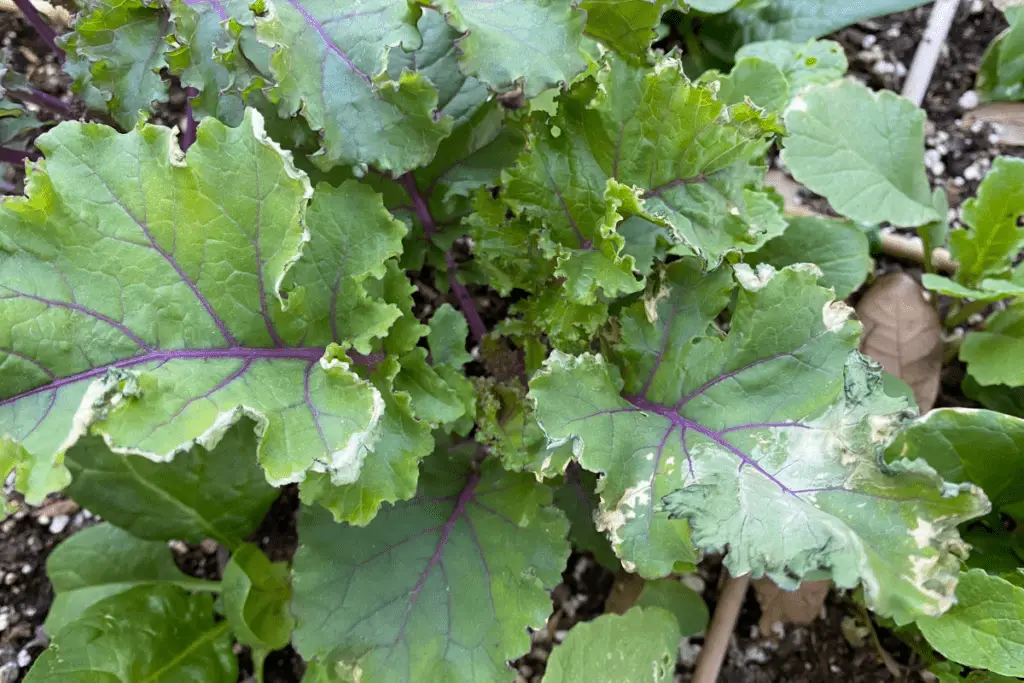
Which Plants Should You NOT Use Neem Oil On?
Neem oil comes from neem trees (Azadirachta indica), which are prevalent in Southeast Asia, and contains the naturally occurring chemical azadirachtin that makes neem oil such a potent organic insecticide.
Once it’s been diluted in soapy water and applied to plants, neem oil will remain effective for up to 1 week before it needs to be reapplied, and after they’ve ingested neem oil, garden pests will usually die in 4-7 days.
Neem oil will harm or kill over 200 insect pests, including most soft-bodied bugs as well as the nymphs of various hard-bodied insects. Thankfully, research has shown that neem oil is very safe for ladybugs and mostly safe for beneficial pollinators and predatory bugs.
One of the primary problems with neem oil is not applying too much of it to your plants, which is possible but unlikely. The bigger issue has to do with which plants you choose to spray with neem oil, how strong your neem oil spray is, and what time of day you spray your plants.
But before we cover those topics, let’s take a close look at plants that tolerate neem oil, plants that are somewhat sensitive to neem oil, and plants that don’t typically need any neem oil applications.
Plants in the “Neem Tolerant” column can handle neem oil sprays fairly well, although you’ll need to spray in the early evening to avoid foliage burns and you’ll want to keep several things in mind if you spray neem oil before a harvest.
Anything listed in the “Neem Sensitive” column below are plants that do better with insecticidal soap spray than they do with neem oil spray, mostly because I’ve seen firsthand how neem can burn plants with delicate foliage even when mixed properly and applied late in the day.
The one oddity in this column is kale: I’ve sprayed mature kale plants with neem oil, and they’ve weathered it just fine. But I recently sprayed young kale plants with neem oil, and it burned their foliage. So I’ve listed kale as a neem sensitive plant in order to caution you about using neem oil on young kale plants. If you need to do so, spray them with a very light spray, then monitor what happens next.
In general, can you spray neem sensitive plants with neem oil? Of course. But doing so can result in possible damage to the plant, so if these plants are infested with bugs, I prefer to use an insecticidal soap and leave the neem oil spray to plants with hardier foliage.
Any plants listed in the “Neem Unnecessary” column don’t really need to be treated with neem oil all that often (if ever!) because they tend to repel or be ignored by the very bugs that neem is designed to eradicate.
I’ve only listed a few flowers here–mostly those that I like to plant in my own garden and thus experiment with when it comes to neem oil–but I find that I rarely spray these plants with neem oil. I use marigolds as a spider mite trap crop, so I’ll sometimes spray them if I notice foliage stippling caused by spider mites and happen to be spraying nearby plants, but I otherwise let them do their thing without additional spraying.
Here’s my list of plants that you can spray with neem oil and others that you might want to avoid spraying with neem. If you’ve had a different experience with neem oil and would like to share, please get in touch with me. I’d love to hear about your experiments with neem oil.
| Plant | Neem Tolerant | Neem Sensitive | Neem Unnecessary |
|---|---|---|---|
| Arugula | ✔ | ||
| Basil | ✔ | ||
| Beans | ✔ | ||
| Beets | ✔ | ||
| Bok Choy | ✔ | ||
| Broccoli | ✔ | ||
| Brussels Sprouts | ✔ | ||
| Cabbage | ✔ | ||
| Caraway | ✔ | ||
| Carrot | ✔ | ||
| Cauliflower | ✔ | ||
| Celery | ✔ | ||
| Chives | ✔ | ||
| Cilantro | ✔ | ||
| Collards | ✔ | ||
| Corn | ✔ | ||
| Cowpeas | ✔ | ||
| Cucumber | ✔ | ||
| Dill | ✔ | ||
| Eggplant | ✔ | ||
| Fennel | ✔ | ||
| Garlic | ✔ | ||
| Kale | ✔ | ||
| Kohlrabi | ✔ | ||
| Lavender | ✔ | ||
| Leeks | ✔ | ||
| Lemongrass | ✔ | ||
| Lettuce | ✔ | ||
| Marigold | ✔ | ||
| Marjoram | ✔ | ||
| Melon | ✔ | ||
| Mint | ✔ | ||
| Mustard | ✔ | ||
| Okra | ✔ | ||
| Onion | ✔ | ||
| Oregano | ✔ | ||
| Parsley | ✔ | ||
| Parsnip | ✔ | ||
| Pea | ✔ | ||
| Pepper | ✔ | ||
| Potato | ✔ | ||
| Pumpkin | ✔ | ||
| Radish | ✔ | ||
| Rhubarb | ✔ | ||
| Rutabaga | ✔ | ||
| Rosemary | ✔ | ||
| Rue | ✔ | ||
| Sage | ✔ | ||
| Scallion | ✔ | ||
| Shallot | ✔ | ||
| Spinach | ✔ | ||
| Squash | ✔ | ||
| Strawberry | ✔ | ||
| Sunflower | ✔ | ||
| Sweet Potato | ✔ | ||
| Swiss Chard | ✔ | ||
| Tansy | ✔ | ||
| Tarragon | ✔ | ||
| Tomatillo | ✔ | ||
| Tomato | ✔ | ||
| Thyme | ✔ | ||
| Turnip | ✔ | ||
| Watercress | ✔ | ||
| Watermelon | ✔ | ||
| Zinnia | ✔ |
If you’re interested in learning more about neem oil, check out the material below. I’ve also included additional neem oil-related articles at the bottom of this post in case you want to read further.
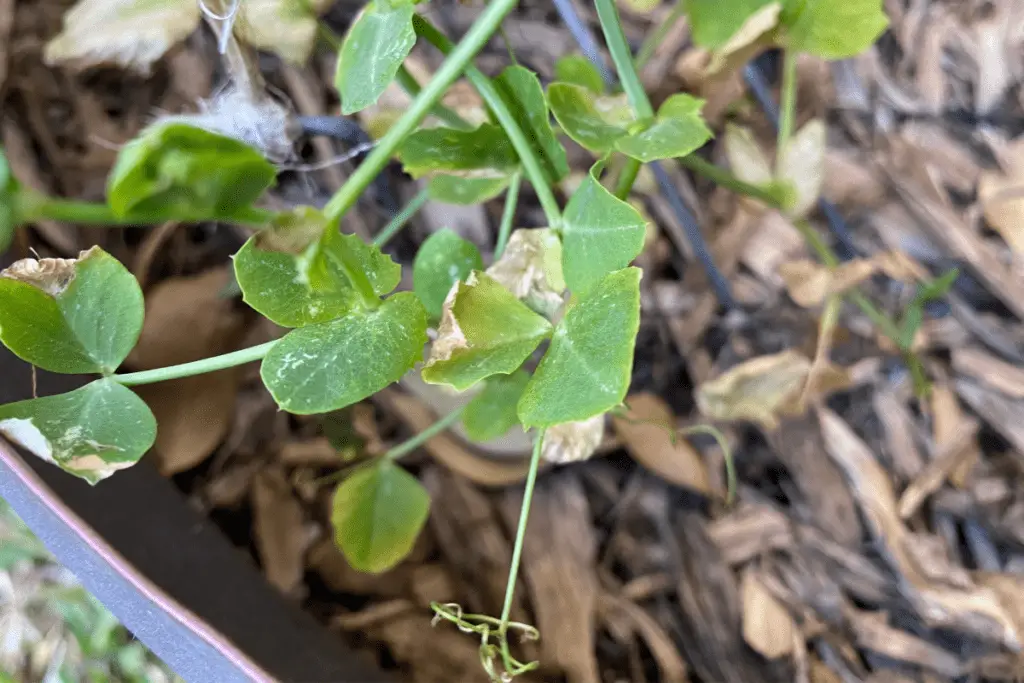
Can Neem Oil Burn Plants?
Neem oil is a powerful natural insecticide, but if you’re not careful, you might unintentionally cause some damage in your garden.
Neem oil can burn plants if applied during daylight hours, especially during the hot summer months. Late afternoons or early evenings are best for spraying plants with neem oil since there’s enough sunlight for visibility but plenty of time for the neem oil to dry before things heat up outside.
I’ve seen plenty of bloggers recommend spraying neem oil in the mornings, but from personal experience, I’m not a fan of this approach. I damaged several tomato plants one season when I sprayed them with neem oil in the early morning (around 6:30am). The neem oil clearly didn’t have enough time to dry before the sun rose and began cooking the plants’ foliage.
I prefer to wait until later in the day to do so: I want enough sunlight to see clearly, but I want the sun to be as low on the horizon as possible.
I’ve found that it’s generally difficult to spray your plants too much with neem oil–and thus it’s typically unnecessary to ever rinse it off–but neem-sensitive plants don’t do as well with heavy spraying. Tomato plants handle neem oil just fine, even under heavy spraying, but I found that spinach, lettuce, and other plants don’t like heavy neem oil sprays.
Neem oil is perfectly safe for all kinds of fruits and vegetables, but some plants can handle things better than other plants, as I’ve noted in the chart above.

Can Neem Oil Kill Plants?
Neem oil can clearly burn plant foliage, but is it possible for neem oil to kill an entire plant?
Neem oil won’t typically kill mature plants, although it can damage foliage and stunt plant growth. Plant seedlings are much more susceptible to neem oil–and can be killed if sprayed with neem oil and exposed to sunlight–so care should be taken whenever using neem oil around seedlings.
In general, I don’t need to use neem oil on my seedlings because it’s usually cold outside when my seedlings are taking off–which means that many bugs are still overwintering and thus relatively inactive–but I had to deal with aphids on my pepper seedlings last year.
I didn’t want to risk spraying them with neem oil, especially since neem takes 4-7 days to kill most bugs, so I carefully squashed them with my fingers and gave the seedlings a very light misting of insecticidal soap spray to hopefully kill off any aphids that I had missed with my fingers.
How to Dilute Neem Oil for Plants
The process I follow when it comes to diluting neem oil involves using a garden sprayer, a bottle of neem oil concentrate, and some organic liquid soap.
I’ve explained my dilution recipe and my treatment methods in extensive detail (including photos from my backyard) in these articles:
- 9 Reasons Your Neem Oil Might Not Be Working
- Can Plants Recover from Spider Mites? What You Need to Know
- Using Neem Oil to Kill Spider Mites: A Complete Guide
- What Plants Do Spider Mites Like, and What Do They Hate?
But if what you’re looking for is just a simple recipe, here are the steps I take to mix mine as well as the products I’ve used with great success in my garden:
1. Fill a garden sprayer with enough water to get the job done.
Over my years of gardening, I’ve used a Flo-Master ½ Gallon Sprayer, Chapin 1 Gallon Sprayer, and the Chapin 2 Gallon Sprayer, depending on how many plants I need to spray at once.
2. Mix 2 tablespoons of neem oil per gallon of water.
These are the two products that I prefer: Neem Bliss Neem Oil or Verdana Neem Oil.
3. Mix 1 tablespoon of organic liquid soap per gallon of water.
These are the 3 soaps that I use: Dr. Bronner’s Peppermint Castile Soap, Mrs. Meyer’s Liquid Hand Soap, or Safer Brand Insecticidal Soap.
You can use other liquid soaps, but soaps like Dawn have additional chemicals in them that are designed to cut down on grease, and I’d prefer to keep unnecessary chemicals out of my garden.
4. Shake well, then pressurize the sprayer and begin spraying.
That’s all it takes to mix a potent neem oil spray!
Just remember: Don’t spray during the day. Ever. If you do, you’ll definitely burn your plants.
Once you mix your spray, be sure to apply it as soon as possible, so I recommend mixing the neem oil solution as the sun begins to set and spraying while you still have full visibility.
Additional Information
Neem oil is a wonderful garden insecticide, but you’ll do best to learn as much as possible about neem oil before you start spraying it on your plants.
If you’d like to keep learning, take a quick look at the articles below so that you’ll be well-prepared to start using neem in your garden:


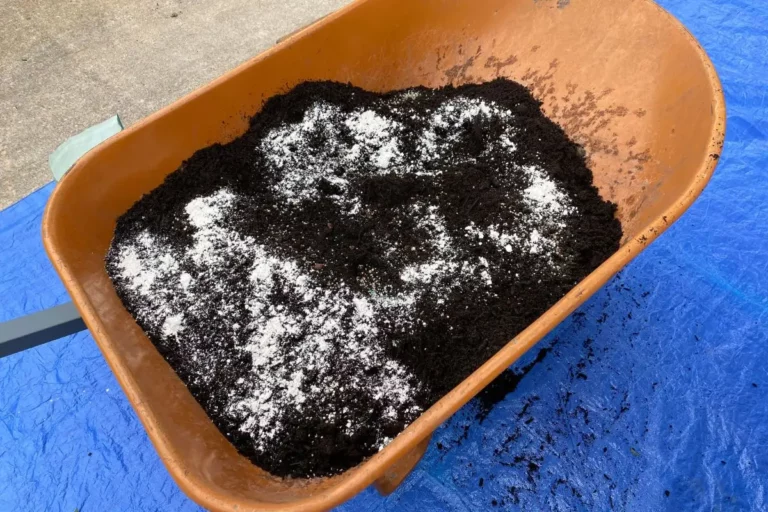
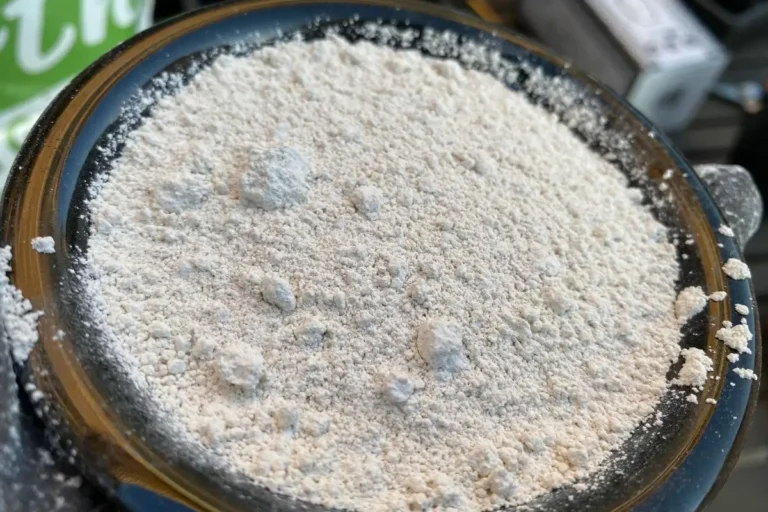
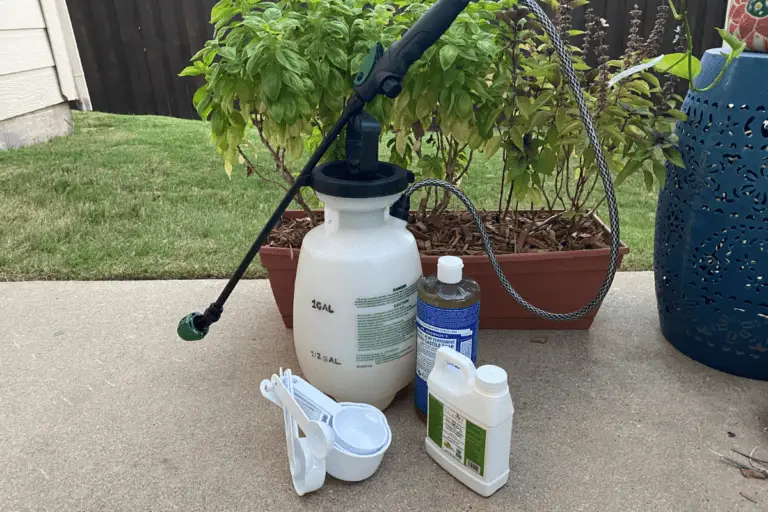

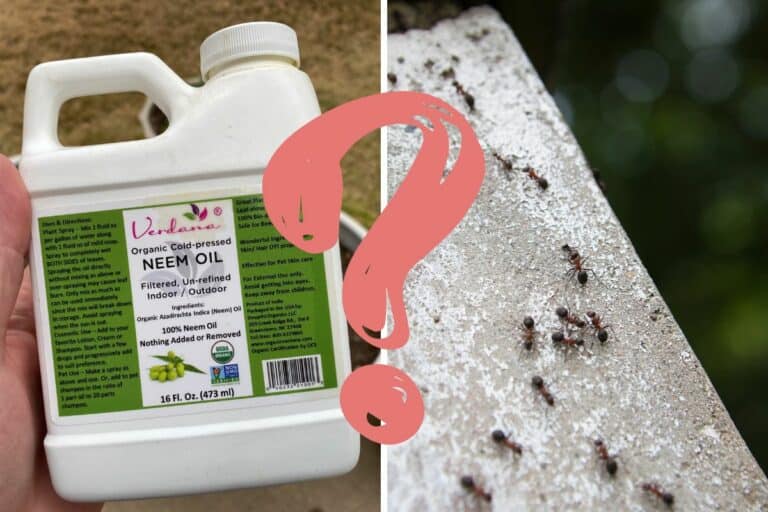
Thank you so much! This was so useful and informative! 🙂
Thanks, Sue. I’m glad I could help. Good luck with your garden in 2024!